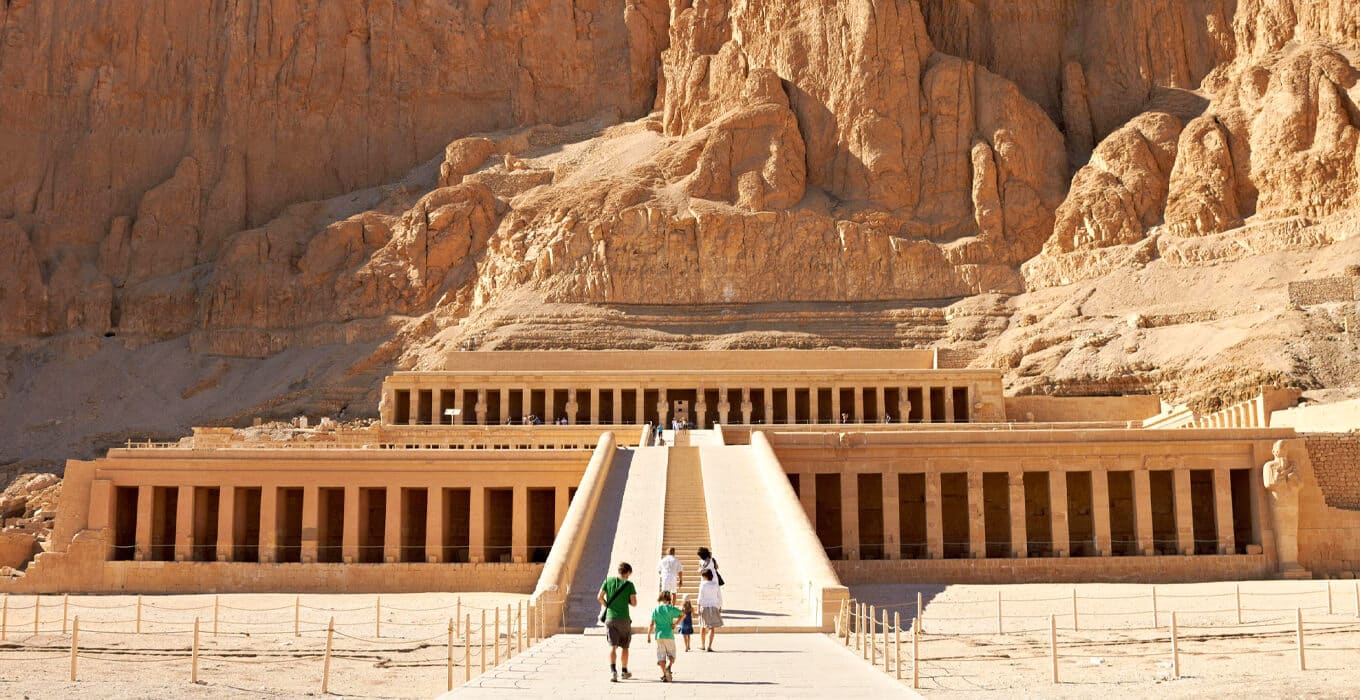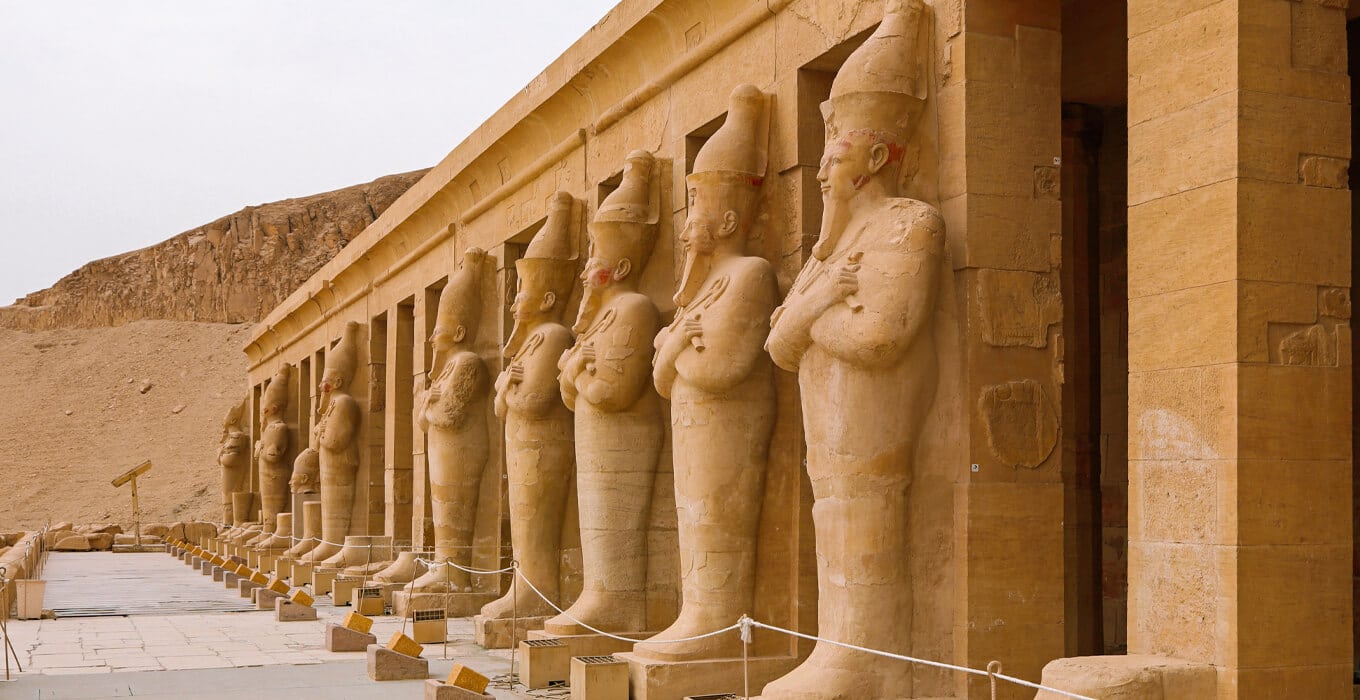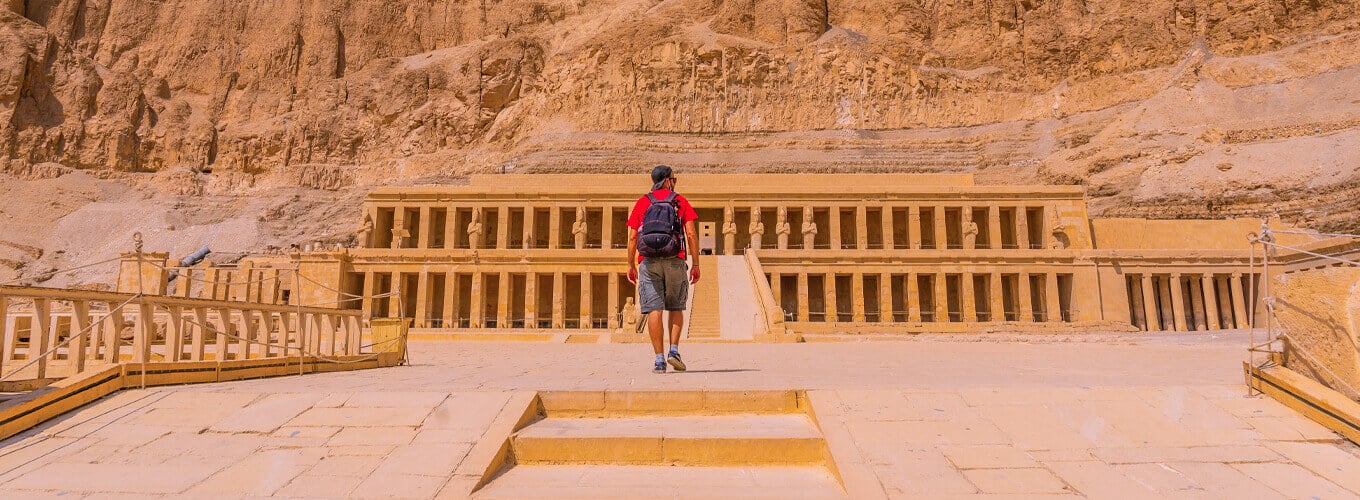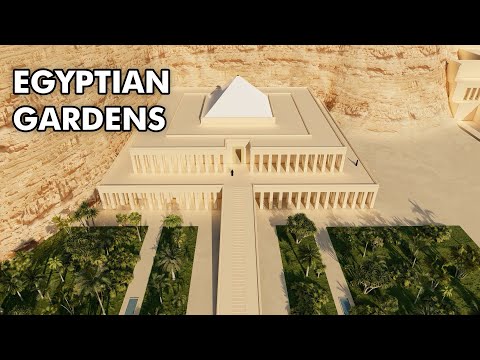The mortuary Hatshepsut Temple is a huge monument to ancient Egypt’s skill. It stands tall at 24.5 meters (80 feet). Located on the West Bank of the Nile, opposite Luxor, it’s called the Djeser-Djeseru or “Holy of Holies.”
This temple is a work of the Eighteenth Dynasty. It has a special design that goes up from the desert floor into the cliffs. It’s a sight to see.
Hatshepsut was a female pharaoh who brought stability and wealth to Egypt. Her temple shows her vision and lasting impact. It’s a UNESCO World Heritage site that takes you back in time.
Key Takeaways
- The Mortuary Temple of Hatshepsut is a colossal architectural masterpiece located in Deir el-Bahari, opposite the city of Luxor on the West Bank of the Nile.
- The temple is a testament to the architectural prowess and political legacy of Hatshepsut, a remarkable female pharaoh who ruled during the Eighteenth Dynasty.
- Featuring a unique terraced design, the temple rises 24.5 meters (80 feet) high and covers an impressive area of 273.5 meters (897 feet) long and 105 meters (344 feet) wide.
- The temple has a long and storied history, having endured damages and repairs over the centuries, and was recently reopened to the public in 2023 after extensive restoration efforts.
- Hatshepsut’s mortuary temple is a UNESCO World Heritage site that offers visitors a glimpse into the grandeur and sophistication of ancient Egyptian architecture and culture.
Introduction to Hatshepsut’s Mortuary Temple
The Mortuary Temple of Queen Hatshepsut is a key example of ancient Egypt’s architectural greatness. Hatshepsut was a female pharaoh who ruled for 20 years. She made a big impact on Egypt’s history and culture.
Overview of Hatshepsut’s Reign and Achievements
Hatshepsut became pharaoh by taking on male titles. This move helped her rule with full power. She built many big projects, like her Mortuary Temple. This temple shows her vision and the skill of Egyptian builders.
Significance of the Mortuary Temple in Ancient Egyptian Architecture
The Mortuary Temple of Hatshepsut is a key example of New Kingdom architecture. It has a special design, beautiful reliefs, and shrines for gods. The temple’s design and size make it a masterpiece of Ancient Egyptian Architecture.

|
Key Facts About Hatshepsut’s Mortuary Temple |
Value |
|
Construction Period |
1479 – 1458 BC |
|
Architectural Layout |
Three-tiered terraced design |
|
Prominent Features |
Colonnade, obelisks, chapels, hieroglyphic scenes |
|
Dedicatory Deities |
Anubis, Hathor, Amun, Re, Thutmosis I |
|
Visitor Highlights |
Architectural grandeur, historical significance, lush gardens |
Location and History of the Mortuary Temple
Hatshepsut’s amazing temple is at the foot of cliffs on the Luxor West Bank. It’s at 25°44’17.8″N 32°36’23.7″E. Built in the Late Bronze Age, it was made between her seventh and twentieth years as queen. It was inspired by the Temple of Mentuhotep II, built 600 years before.
Coordinates and Geographic Setting
The temple’s spot, with its link to the Valley Temple via a 1-kilometer causeway, shows its builders’ skill. It’s in the Deir el-Bahri area. This spot made it a key landmark, seen from far and drawing the eye of all who came to Thebes.
Historical Background and Construction Timeline
- The Mortuary Temple of Hatshepsut was built during Queen Hatshepsut’s rule, from 1479 to 1458 BCE.
- Work started around 1479 BCE and took about 15 years, led by architect Senenmut.
- The design took cues from the Temple of Mentuhotep II, built 600 years earlier, in the Late Bronze Age.
- Hatshepsut’s time was filled with successful trade, a strong economy, and many public projects. This gave jobs to many Egyptian workers.
The Mortuary Temple of Hatshepsut shows ancient Egypt’s skill in building big structures. It proves the country’s ability to make things that last for thousands of years.
Architectural Features and Design
The Mortuary Temple of Queen Hatshepsut is a stunning example of ancient Egyptian Rock-Cut Architecture. It has a unique terraced layout. Three massive tiers rise above the desert floor, leading to the “Holy of Holies” at the top.
The grand entranceway is impressive, with a portico that sets the stage for the temple’s design. This design is unlike traditional mortuary complexes.
The main axis has the sanctuary of Amun-Re, the main god of Thebes. The mortuary and solar cult complexes are on the sides. Shrines for Hathor and Anubis, the god of mummification, are on the middle terrace.
|
Architectural Feature |
Description |
|
Terraced Layout |
The temple features a unique three-tiered design, rising above the desert floor and leading to the “Holy of Holies” at the top. |
|
Grand Entranceway |
The temple’s entrance is fronted by an impressive portico, setting the tone for the innovative architectural elements. |
|
Shrine Arrangement |
The placement of shrines and sanctuaries, including those dedicated to Amun-Re, Hathor, and Anubis, is distinct from traditional mortuary complexes. |
The Mortuary Temple of Queen Hatshepsut shows the amazing architectural skills of ancient Egypt. It combines innovative design with respect for the region’s traditions.
Mortuary Temple of Hatshepsut
The Mortuary Temple of Hatshepsut is a famous spot in ancient Egypt. It’s called the Djeser-Djeseru or “Holy of Holies.” It’s in the Deir el-Bahri area on the West Bank of Luxor. This temple shows Hatshepsut’s big dreams and her drive to build something great.
Hatshepsut was a pharaoh for over 20 years in the 18th dynasty. Her temple is next to the Temple of Mentuhotep II. It was a place where she showed off her power and the god Amun-Re.
Her temple has many scenes from her time as pharaoh. It also has shrines for gods like Anubis, Hathor, Amun, and Re.
But, her stepson Thutmose III tried to erase her memory about 20 years after she died. He destroyed many images of Hatshepsut. Still, the Mortuary Temple of Hatshepsut stands as a sign of her great achievements.
“The Mortuary Temple of Hatshepsut is a stunning example of ancient Egyptian architecture, showcasing the vision and legacy of a truly remarkable ruler.”
Now, the Mortuary Temple of Hatshepsut is in the Deir el-Bahri area and part of the Ancient Thebes with its Necropolis UNESCO site. It welcomes visitors all year, from 9 a.m. to 5 p.m. It’s best to go early to beat the heat.
Visitors can see the temple’s terraces, big entrance, and detailed carvings. They can also see the Valley of the Kings and the Temple of Luxor nearby.
Exploring the Terraces and Porticoes
The Mortuary Temple of Hatshepsut is famous for its terraced layout and big porticoes. You can get to the temple by ramps that split the porticoes. The temple has three big terraces, each with its own special design.
The Terraces
The lower terrace has two Persea trees, T-shaped basins, lying lion statues, and scenes of moving obelisks and giving offerings to gods. The middle terrace has porticoes on the west and east sides. The upper terrace takes you to the festival courtyard and the main place of worship for Amun-Re.
The Porticoes
The portico walls are covered in beautiful reliefs and inscriptions. You’ll see scenes of Hatshepsut’s trip to the Land of Punt and her divine birth. The lower terrace has 44 columns in two rows. The middle terrace has 22 columns in the west portico and 15 in the north portico.
|
Terrace |
Dimensions |
Portico Columns |
|
Lower |
120 m (390 ft) deep by 75 m (246 ft) wide |
44 columns (2 rows of 22 each) |
|
Middle |
75 m (246 ft) deep by 90 m (300 ft) wide |
37 columns (22 in west, 15 in north) |
|
Upper |
Encompassing 26 columns with 5.2 m (17 ft) tall Osiride statues of Hatshepsut |
26 columns |
The temple’s design, with its terraced layout and fancy porticoes, shows Hatshepsut’s vision and the ancient Egyptian builders’ skill.
Shrines and Sanctuaries within the Temple
The Mortuary Temple of Hatshepsut in Egypt has many important shrines and sanctuaries. These places show the temple’s deep religious and symbolic meaning. The Hathor Chapel and the Anubis Chapel are key spots for funerary rites and rituals.
Hathor Chapel: Honoring the Goddess of the Deir el-Bahri
The Hathor Chapel is on the middle terrace of the temple. It has columns with Hathor-headed capitals. This design honors the goddess Hathor, the protector of Deir el-Bahri.
Hathor, known as the “Lady of the West,” was vital in the temple’s rituals. She linked the living with the dead. The chapel’s design shows Hatshepsut’s deep respect for this powerful goddess.
Anubis Chapel: The God of Embalming and the Cemetery
The Anubis Chapel is at the north end of the middle terrace. It is dedicated to Anubis, the god of embalming and the cemetery. Anubis was key in the mummification process and the afterlife journey.
This chapel shows the temple’s role in funerary rites. Anubis was a big part of the temple’s religious and mortuary rituals.
The temple also had a main sanctuary for Amun-Re, a solar cult court, and a mortuary cult complex. These areas added to the temple’s wide religious and symbolic importance in ancient Egyptian society.
Osiride Statues and Artistic Representations
The Mortuary Temple of Hatshepsut is famous for its Osiride statues. These statues show the ruler as the god Osiris. Osiris was the god of the underworld and of fertility and resurrection. The statues mix Hatshepsut’s feminine look with the Pharaonic regalia. This includes the Double Crown of Egypt and a fake beard. They show Hatshepsut as both a female leader and a god on earth.
The temple also has other art that shows Hatshepsut’s importance. A relief has the falcon-headed god Horus wearing the Double Crown. This symbolizes the pharaoh’s right to rule and their link to the gods.
- The model of the temple of Hatshepsut at Deir el-Bahri was made in 1934 and 1935. It shows how much people love this place.
- Finding Hatshepsut statues added a lot to the New Kingdom galleries of the Museum starting from 1929. Now, visitors can see the pharaoh’s art.
- The temple model was fixed in 2013 before going to an exhibition in Tokyo. This shows the effort to keep and share this amazing site.
Hatshepsut’s art, like the Sphinx and the Osiride Statue head, shows her in Pharaonic regalia. This made her look like a man to show she was the true ruler. These images changed the usual gender roles in ancient Egypt. They showed how Hatshepsut could go beyond what was expected of her.
Restoration and Conservation Efforts
The Mortuary Temple of Hatshepsut has seen a lot over the years. It was destroyed by her stepson Thutmose III, then fixed by later pharaohs. This ancient place has survived a lot.
Historical Excavations and Archaeological Discoveries
After Hatshepsut ruled, her stepson Thutmose III tried to remove her name. Many of her statues were destroyed. The Amarna Period under Akhenaten also damaged it. But, Tutankhamun, Horemheb, and Ramesses II fixed it again.
The first big dig started in the 1890s. American Egyptologist Herbert Winlock worked on it for 25 years. Since 1961, the Polish Centre of Mediterranean Archaeology (PCMA) has been helping to rebuild the temple.
Ongoing Preservation Initiatives
Today, the temple is being saved thanks to the PCMA. In the Ptolemaic period, the area was changed again. A Coptic monastery was built there later. Now, the Main Sanctuary of Amun-Re is open to everyone since 2017.
New rooms in the temple and the nearby tomb of Meru opened recently. This is thanks to years of hard work by many experts.
|
Year |
Restoration Efforts |
Key Findings |
|
1890s |
First large-scale excavation of the temple complex |
Uncovered various architectural and artistic elements |
|
1925-1950 |
Restoration work by American Egyptologist Herbert Winlock |
Lasted for 25 years, focused on documentation and reconstruction |
|
1961-present |
Polish Centre of Mediterranean Archaeology (PCMA) expedition |
Ongoing documentation, conservation, and reconstruction efforts |
|
2017 |
Opening of the Main Sanctuary of Amun-Re to the public |
Allowed visitors to explore this significant part of the temple |
|
2023 |
Opening of new rooms in the Temple of Hatshepsut and the tomb of Meru |
Result of years of work by archaeologists, conservators, and architects |
Visiting the Mortuary Temple Today
The Mortuary Temple of Hatshepsut is a wonder of ancient Egypt. It’s located under the cliffs of Deir el-Bahari, by the Nile River. It’s a key spot for those visiting the Theban Necropolis.
Best Times to Visit and Practical Tips
The temple is open from 9 a.m. to 5 p.m. all year. It’s best to go early to beat the heat. You can buy tickets there or get a tour package that includes entry.
A taxi from Luxor Bridge to the Visiting Hatshepsut’s Temple takes 30 minutes for $6.
Nearby Attractions in the Theban Necropolis
The Theban Necropolis has many ancient sites. Near Hatshepsut’s Temple, you can see the Valley of the Kings, the big Karnak Temple Complex, and the beautiful Temple of Luxor. These places show the history and culture of ancient Egypt.
|
Attraction |
Distance from Hatshepsut’s Temple |
Approximate Travel Time |
|
Valley of the Kings |
8 km |
20 minutes |
|
Karnak Temple Complex |
12 km |
30 minutes |
|
Temple of Luxor |
15 km |
40 minutes |
“The Mortuary Temple of Hatshepsut is a true masterpiece of ancient Egyptian architecture, a testament to the power and grandeur of this remarkable civilization.”
Legacy and Influence of Hatshepsut
Hatshepsut was a key figure in ancient Egypt’s history. She was one of the first women to rule as a pharaoh. Her rule showed her smart politics and her vision for architecture.
Hatshepsut’s Impact on Egyptian History and Culture
Hatshepsut is known as a Female Pharaoh. She ruled for almost twenty years alongside her nephew-stepson, Thutmose III. Her big projects, like the Mortuary Temple of Deir el-Bahri, show her skill in building and ruling.
The Enduring Significance of Hatshepsut’s Temple
The Mortuary Temple of Hatshepsut is a great example of Ancient Egyptian Architecture and Art. Even when people tried to forget her, her temple remains. It shows her strength and the skill of ancient Egyptian artists.
“Hatshepsut reigned as a female pharaoh for nearly twenty years in the fifteenth century B.C., during the early period of the New Kingdom.”
Hatshepsut’s story has made people think more about women’s roles in ancient Egypt. Her temple is a lasting reminder of her vision and ambition. It shows how Hatshepsut’s Legacy still affects ancient Egypt’s culture.
Conclusion
The Mortuary Temple of Hatshepsut is a key piece of ancient Egypt’s history. It shows the vision and success of a great ruler. Its unique design and detailed carvings highlight the ambition and skill of Hatshepsut’s time.
Even though Thutmose III tried to remove Hatshepsut’s name, the temple still stands strong. It lets us see the beauty of ancient Egyptian life. Visitors see the big entrance, wide terraces, and statues. They learn about Hatshepsut’s big wins in building.
The temple still draws people to Theban Necropolis. It shows how important Hatshepsut is in ancient Egyptian history and culture.
Read our related articles:


